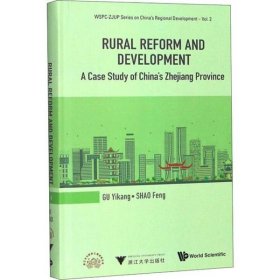
Rural Reform and Development: A Case Study of China's Zhejiang Province(走向城乡发展一体化的浙江农村改革与发展)
正版保障 假一赔十 可开发票
¥ 168.09 6.3折 ¥ 268 全新
仅1件
作者Gu Yikang,Shao Feng[著]
出版社浙江大学出版社
ISBN9787308186827
出版时间2019-10
装帧精装
开本其他
定价268元
货号9639751
上书时间2024-12-23
- 最新上架
商品详情
- 品相描述:全新
- 商品描述
-
作者简介
顾益康,曾任浙江省农业和农村工作办公室原副主任,现为浙江省人民政府咨询委员会委员、“三农”发展组组长、中国城郊经济研究会副会长、中国农业经济学会常务理事、浙江省农业经济学会会长等。在“三农”问题理论研究和实践探索上有较强造诣。
目录
Introduction The "Farmers Miracle" and People- Oriented Development Economics
??I. The core concept of development
??II. The driving mechanism of development
??III. The capital accumulation of development
??IV. The path of development
??V. The institutional supply of development
??VI. The humanistic foundation of development
??VII. The universal significance of people-oriented development economics
Chapter I??The General Trajectory of Reform and Opening-Up in Rural China
??I. The implementation of the household contract responsibility system and the establishment of the rural basic operating system
??II. The booming township enterprises and towniets and the promotion of rural industrialization and urbanization
??III. The reform of the property fights system of township enterprises and small towns, and full establishment of market economy system in rural areas
??IV. The implementation of the balanced urban-rural development strategy and comprehensive promotion of the establishment of a new sot countryside
Chapter 2??Reform of the Agricultural Management System and Transformation from Traditional Agriculture to Modern Agriculture
??I. Reform of the agricultural management system
??II. Transformation from traditional agriculture to modem agriculture
??III. Changes of agricultural development strategy
Chapter 3??Changes and Development of the Rural Cooperative Economy
??I. Changes and development of the rural cooperative economy
??II. Reform and development of the rural supply and marketing cooperative economy
??III. Reform and development of rural credit cooperatives
??IV. The rise and development of rural specialized cooperative economic organizations
Chapter 4??The Development of Township Enterprises and Rural Industrialization
??I. The emergence of township enterprises as a new force
??II. The continuous growth of household industry and individual business amid controversies
??III. The property fights reform of rural collective enterprises
??IV. From dispersion to agglomeration--the development of township enterprises
??V. The marketing of township enterprises
??VI. The soft power of township enterprises
??VII. Township enterprises giving back to agriculture, rural areas and farmers (three rural issues)
Chapter 5??Urban Construction and Rural Urbanization
??I. The development of small towns built by farmers
??II. Central-town-centered mode of development
??III. Comprehensive reform of small towns
??IV. Small towns as the hub of urban and rural areas
Chapter 6??County-Based Economic Development and Transformation in the Rural Economic Structure
??I. Structural reforms in county ownership and development in the non-public sectors of the economy
??II. The growth of county-specialized block economy
??III. The growth of specialized markets
??IV. The growth of farmers income and its changing sources
??V. Reforms in the management structure of county economy
Chapter 7??Transfer of Agricultural Labor Force and Division of Labor Among Farmers
??I. The trend of agricultural labor force transfer
??II. The main driving force of agricultural labor force transfer
Chapter 8??Village Renovation and Rural Community Transformation
??I. Village arrangement, homestead re-arrangement and central village construction
??II. The construction of new rural communities
Chapter 9??Social Construction and Public Service Development in Rural Areas
??I. Balanced development of urban and rural education
??II. Integrated urban and rural public health service
??III. The improved rural public cultural service system
??IV. The gradual urban-rural integration of the social security system
Chapter 10??Poverty Alleviation in Rural Areas and Accelerated Development in Underdeveloped Regions
??I. The development of rural poverty alleviation
??II. Changes in rural poverty and the transition of poverty alleviation and development strategy
??III. The comprehensive promotion of the development of underdeveloped areas and low-income farmers striving for a prosperous life
Chapter 11??"Yiwu Business Circle" Division of Labor Collaboration Network
??I. Establishment of the villager autonomy system and development of grassroots democracy
??II. Establishment and improvement of the rural administration instructor system
??III. Transition and improvement of the rural governance structure
Bibliography
Epilogue






















以下为对购买帮助不大的评价